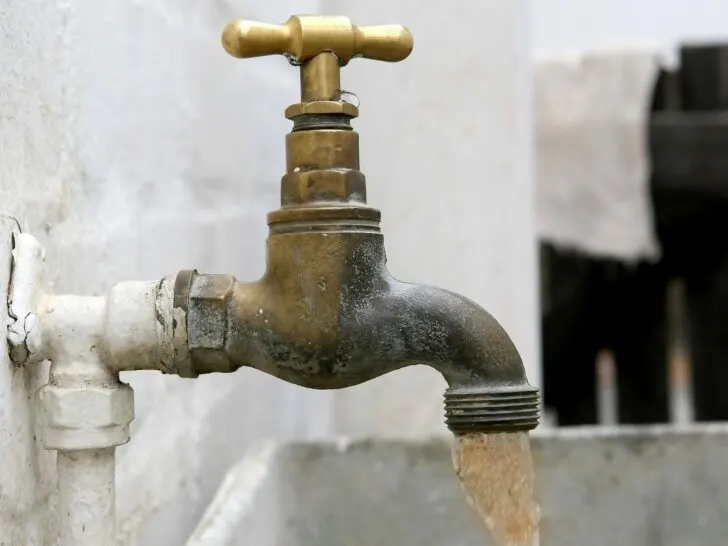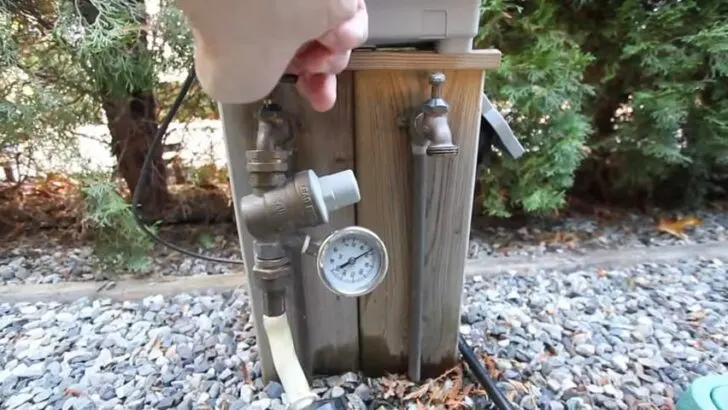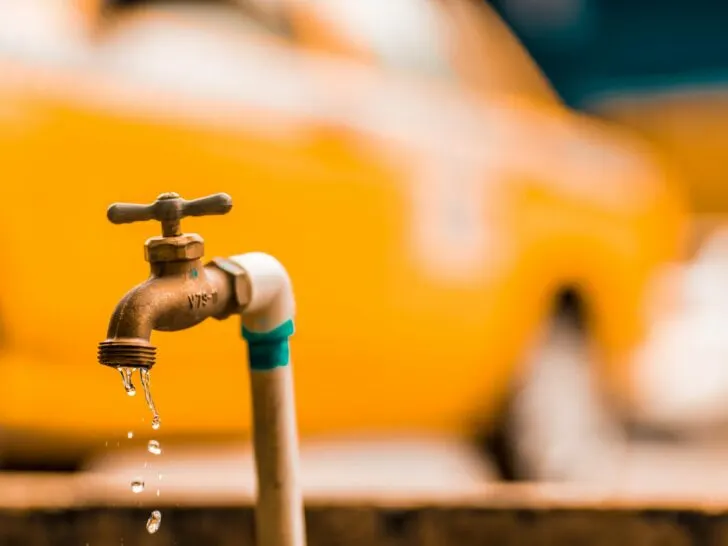One of the benefits of traveling in an RV is having an available supply of water in your RV’s fresh water tank. If you’re car or tent camping, you’re more limited in the amount of water you can bring along. Having a fresh water in your tank provides all the water you need for drinking, showering, and washing dishes. But where can you go to fill an RV fresh water tank?
The tanks are so large on some RVs, you could be boondocking (camping without hook-ups) for days… or even weeks… and not worry about running out of water. Regardless of the size of your RV fresh water tank, some rules are an absolute must to follow.
Tips for Filling an RV Fresh Water Tank
Filling an RV fresh water tank is pretty straightforward, but some tips need to be followed to keep your drinking water safe. Depending on the type of RV you have, you may be able to use an exterior water connection to fill your tank, either through a fill port in the side of the RV (a “gravity fill”) or by connecting your plumbing system directly to the external water supply.
Other RVs have a dedicated fresh water fill connection, or (like ours) have a diversion valve that takes water from the “City Water” connection and directs it to the fresh water tank. Just remember that when filling your tank it’s best to monitor your progress, so you know when it’s full. A key point is to try not to fill more than you need for your stay.
Water weighs approximately 8.3 pounds per gallon, so it’s safe to say that it’s heavy! A full fresh water tank could add several hundred pounds to your RV. This means that traveling hundreds of miles with a full fresh water tank would be harder on your engine and brakes, and use considerably more fuel (check out our last post What’s the Typical Fuel Economy of a Class A Motorhome?).
If there’s a place where you can fill up your RV fresh water tank near your destination, this is the ideal approach. This way you can travel light and get as much water as you need just before parking.
Your RV Fresh Water Tank
When filling your RV fresh water tank, there are a few hard and fast rules that should be followed to stay safe. Most importantly, always use potable water, also known as drinkable water. There’s typically a sign around the water spigot that lets you know if the water is not potable, such as at an RV dump station.

Water sources labeled as “non-potable” are not safe for drinking, cooking, brushing your teeth or washing!
We can’t stress this enough: if it’s not potable, do not use it, unless you know you’ll never drink the fresh water from your RV tank. Almost all water at dump stations is non-drinkable. Again, if it’s not marked as “potable,” that means it’s water that can’t be guaranteed to be clean, and is therefore not safe to drink.
If you ever do use non-potable water in your fresh water tank, you will absolutely need to sanitize your water system so that it’s safe to drink from again.
Another great safety tip is to have a designated hose that’s only for fresh water. If you use a hose with non-potable water, your hose is contaminated, and you shouldn’t drink water from it. If you use your hose to clean out your dump tanks in any capacity, never use that same hose to fill your fresh water tank! Your drinking water hose is solely for clean, potable fresh water and nothing else.
- Constructed with NTS Reflex Mesh patented technology eliminates kinks, twists and tangles
- Lead-free, complies with Consumer Product Safety Improvement Act for lead content
Lastly, when using your fresh water hose, always use an inline filter and a water pressure regulator. Both of these products will keep your water safe, and prevent any damage to your RV’s plumbing system.
How to Find Places to Fill Your RV Fresh Water Tank
When it comes to finding places to fill your RV fresh water tank, we recommend your favorite campground app. Apps/websites like The Dyrt (now offering a free 30-day trial here!), RV Trip Wizard, and Campendium do their best to provide valuable information around water and dump stations. Apps are also helpful because people leave reviews, meaning you can learn about fees, access, and other details before arriving.
5 Places to Fill Your RV Fresh Water Tank
When it comes to tried and true places to fill your RV fresh water tank, you can always count on the five places noted below:

Campgrounds are among the best places to find potable water to fill your fresh water tank!
1. Campgrounds
One of the best places to find potable water is at the local campground. Almost every type of campground offers potable water, either included with your stay, or for a small fee. If you’re looking to boondock, you can call a nearby campground along the way and see if you can stop by to fill your water tank.
Some RVers will stay a night or two, fill up their tank, and head to their boondocking spot with their resources refreshed. Other campgrounds may have a dedicated dump station (often for a separate fee) where there’s also access to potable water… or may allow you to connect to water in an empty campsite (again, sometimes for a fee).
2. Travel Centers
Travel centers are another excellent place to find potable water. But not all travel centers have a fill station, so you’ll want to check ahead before arriving. Typically, if you call ahead and ask, the attendee can provide you with all the details on where the spigot is located, and any special instructions you may need for finding/using it.
3. Rest Stops
Rest stops are another place you can find potable water. Similar to travel centers, not all rest stops have a site to hook up a hose to fill a tank. We recommend checking your travel apps for information.

Some rest stops and city, county and state parks offer potable water for filling your RV fresh water tank!
Some rest stops also have dump stations, which is fantastic because you can empty your black and gray tanks at the same time you refill your fresh water tank!
4. City, County, and State Parks
Another place to find potable water is at a city, county, or state park. Many of these types of parks offer camping or day-use areas with water. It’s typically harder to get a city, county, or state park rep on the phone to answer questions, so we recommend relying on app reviews to choose the best option for your needs.
5. Cabela’s
Last but not least is Cabela’s. This outdoor recreation company almost always offers RV parking, a dump station, and a potable water fill. While most stores charge a dump fee, we haven’t seen any that charge a fresh water fee. Of course, we always recommend going inside to buy a little something as a “thank you” for the free water.
Conclusion
Water is an essential resource RVers need to travel comfortably, and it’s critical to have plenty of it. The last thing you want is to run out of water when you’re out camping and be forced to leave early. So, make sure to plan accordingly and be safe when filling up your RV fresh water tank!
Click here to see how we keep our RV’s fresh water pure and safe for drinking!
Geek Out with Us Every Week
Join our newsletter to learn about all things RV-related. Every week we offer free tips, tricks, product reviews, and more to our online community of RVers. Whether this is your first time on the road or you’re a seasoned expert, we’d love for you to geek out with us!



Sophia Talbot
Friday 19th of August 2022
FYI. The Cabela’s in Hamburg, PA told us there was no potable water, although we saw a blue painted water pump which usually means potable water. We found water at the Shelll gas station.
Teresa
Thursday 15th of July 2021
Hello, Wanted to say thanks for the great article.
Also a update, just called Cabela’s (Thornton, CO) about RV dump and fresh water fill. They told me they closed it last month.
thanks again, Teresa July 15, 2021
TheRVgeeks
Thursday 15th of July 2021
Thanks, Teresa... both for the kind words and the update on the Thornton Cabela's. Unfortunately, these days it's more common for dump stations (and overnight parking locations) to be closed, not new ones opened. Hope that pattern stops soon!
Ronal Owens
Thursday 1st of July 2021
I have prepared water for us but I am still afraid it will be short, as I am a beginner I don't know what I will do if I run out of water. Thank you for this article.
TheRVgeeks
Thursday 1st of July 2021
Hang in there, Ronal. You can do it! Wishing you safe travels and a great holiday weekend!
Drew
Friday 12th of February 2021
Don't get water in Arizona.
TheRVgeeks
Friday 12th of February 2021
Hi Drew!
Since we usually snowbird in the Desert SW, we don't have much choice but to fill our fresh tank with lousy water during that time. The one thing we do differently down there (here actually, since we're in AZ right now!) is we stop drinking from our fresh tank, since nothing much will make the water taste good.
What we do instead is buy two or three of those 2.5-gallon containers of drinking water... the kind with the little spigot at the bottom... plus a couple of additional 1-gallon containers. We keep the gallon bottles in the fridge so that we have cold drinking water without using ice, and keep one of the 2.5-gallon containers on the counter for re-filling water bottles, etc.
That gives us about 8-10 gallons of drinking water capacity on board. Whenever we go into town, we re-fill them from those Glacier RO machines for about 25 cents a gallon, saving the cost and wasted plastic of continuing to buy more new containers.
When we head back north for the summer, where the water tastes great again, we recycle all the containers. That way we get an entire winter's use out of just a few containers.
Steve Lamb
Friday 12th of February 2021
Hi guys, thanks for the article on water. I have Pex tubing in my RV, what water pressure to you recommend? I bought a RV toilet( Dometic #320 and it seems the water around the bowl seems weak. My regulator is set to 45psi, thanks ~ Steve
TheRVgeeks
Friday 12th of February 2021
Hi Steve! Basic, non-adjustable RV water pressure regulators are set to prevent pressure from exceeding about 50 PSI, and we keep our adjustable regulator set to around 50 PSI as well. We have PEX tubing also, which is pretty standard in just about all RVs. So you're very well within a safe range for RV plumbing and should be good to go.